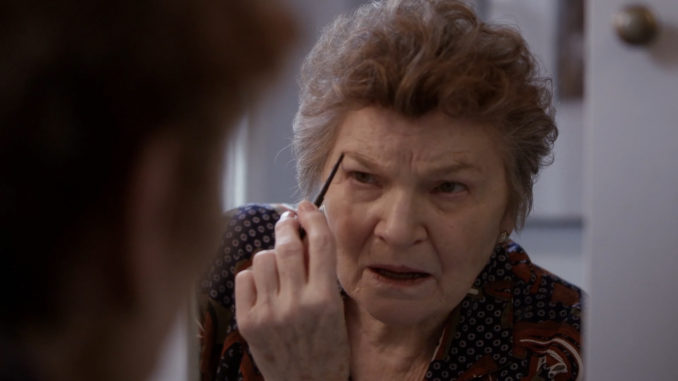
Review Fix chats with Allie Light about the process and inspiration behind her new film, “Any Wednesday.â€
Review Fix: What inspired this film?
Allie Light: The most recent count—2008 to 2016—for suicide among U.S. veterans (men and women) is 6,000 per year. The most common reason for suicide in this group is PTSD – Post Traumatic Stress Disorder.
More women than men are afflicted with dementia. In the year 2001 it was estimated that 3.4 million people in the U.S. had dementia and the numbers would rise.
Any Wednesday is the story of C’Mo, an African American war veteran home from Iraq, who suffers from PTSD and Agnes, a 79 year-old white woman with early stage dementia. The two spend the evening together driving around in Agnes’ car. They find, in one another, the opportunity to speak their fears and to confess the actions their conditions have led to.
It is important to acknowledge the vast numbers of war veterans with PTSD and the little that is being done to help preserve their lives and, in Agnes’s situation, to realize the lonely and frightening feelings of losing one’s sense of self. C’Mo and Agnes will remind us of people we know and love, and how to better understand the trajectories of their lives.
Review Fix: How difficult was this film to put together?
Light: After my filmmaking partner and husband died, I struggled with grief to the point that I had to write about it. Beginning in summer 2015 I wrote four scripts on the subject of grief and desire in old age. Any Wednesday is the first of those scripts. The story is based on my son-in-law’s mother, who went to meditation one night and didn’t come home. After the family called the police and had been searching for her, she called home from a gas station. She had been driving around with a man who had fixed her flat tire. Her family rushed to the gas station but they were gone. She eventually dropped the man off and came home, but because she had dementia, they never knew what happened. I had a blank canvas to write her story.
I have been a documentary filmmaker for 40 years. This is my first dramatic film with actors, so I can make comparisons between the two genres. One could say the film was put together twice: once on location and once in the editing room. I found the process easier than documentary film—I had a script. We shot everything I had written, no changes or added scenes–common occurrences when making a documentary. After the film was shot, we put it together scene by scene in the editing room by following the script and making our choices among the many takes. We did have a few problems with poor sound (a bad mic in the convenience store and generator sound outside) and some underexposure, but we worked around these.
Review Fix: Tell me about the cast.
Light: We cast the film in Vancouver. Patrick had heard about Mary Black and we never considered anyone else for the part. Patrick gave copies of the script to various Vancouver agents and they passed them along to their clients. Fifteen African Canadian and American actors showed up to read for the part of C’Mo. We chose Shane Dean, a rapper, who was moving into acting. The convenience store manager is played by Charles Raahul Singh an actor and a Sikh.
A few days after the film was cast, Mary fractured her pelvis. We didn’t want another actor. This was her role, she was perfect, so we waited for her to heal. During the three month’s wait, Shane, who knew nothing about PTSD, read books and watched TED talks. He came to the set the first day with his own cardboard sign. Our art director redid it using Shane’s words: IRAQI VET MY WAR CONTINUES. From day one, Mary and Shane—Agnes and C’Mo—hit it off. They liked one another and, while waiting for their calls, sat together, talked and laughed.
Review Fix: What was the feeling like on set?
Light: I was excited to be on the set. This was a new experience. We had four nights of shooting and one daylight shoot– the opening scene and the car in front of the church. I had never worked with a crew of 30 people, each with their own skills. In documentary filmmaking we usually had 4 people: my partner and I, a cinematographer and a sound recordist. We four did everything. In making Any Wednesday, we had a costume person, a makeup person. We had an art director. Some people were in charge of creating rain—we had rain towers, Several people, by shaking the car and passing light across it, made the car appear to move. Mary never drove. I saw that the crew was used to working together. People told me they liked my script–they said how happy they were to work on a film that had real meaning. When we had our wrap party and it snowed on the cake, we all laughed and posed for group selfies.
Our producer, Julia Hilder, had worked in television news, and she made a video of the making of the film and how we worked together.
Review Fix: How have the audiences been reacting to it?
Light: People express all kinds of positive feelings about the film. Here are excerpts from a few of the many texts, emails and notes we have received:
Such a touching and surprising friendship between the two leads.
There is tension, suspense, love, regret, guilt.
Totally appealing characters.
Wonderful humor!
The audience loved Any Wednesday. It looked absolutely stunning on the big screen, every word captured on the soundtrack.
The directing, the pace of the editing, the projection of emotional complexities of the two main characters, sublimely acted by the two leads—all contributed to what we saw on the screen.
Your film is magnificent and thrilling. The writing, directing and acting are all mind-blowing.
We were both shaken up in the best way. Everything about the story was unexpected and marvelous—so REAL
We were deeply moved when she answered C’Mo’s question about how to remember him: “Grief.†It was a startling revelation of your themes. You have transformed grief into art in this film.
So many losses — her mind, her husband’s loss of her, the vet’s loss of mind, literally home and family. Their mutual loss of self. The beauty and deep humanity that existed in the moments of their brief encounter was an antidote to their misery. An insight into what we all are capable of.
I loved it that the dog had a mini scene.
a powerful statement of circumstantial differences alongside shared humanity.
From one tense moment to the next, we were riveted to the
screen.
The locations, time of day, art direction and mise-en-scene — all contributed to creating an unsettled, but also heroic mood, as two strangers — each of whom are suffering a loss — take a chance and help one another.
From Israel:
I enjoyed it tremendously. I wanted it to not end, because the protagonists were compelling and made me look closer at my own fears and prejudices.
Review Fix: What films inspired this one?
Light: After our first meeting in Vancouver and I had met and talked to Mark Cohen, our cinematographer, I begin to think of how I wanted the film to look. I have always loved foreign films–that is, films not made in America (we’re foreign to the rest of the world). I find these films slower, quieter with a totally different pace to the storytelling. My favorite film since I first saw it in 2014 is the Polish film, Ida, directed by Pawel Pawlikowski. Ida is a bit of a road film like Any Wednesday is. She and her aunt take off in a car and talk about things that have not been known or mentioned in the past. But it’s not the subject matter that I wanted to match, but the style and pacing of the film. The next time we went to Vancouver, I brought a DVD and gave it to Mark. I asked him to let people move in and out of the shot rather than following them. I asked him to hold the shots long, to give me ‘bookends’ so if I wanted to use more of the shot, I could. I also decided to have music only where it would realistically appear—just as is done in Ida.
Mark was sensitive to my request. He let the action play out within the shot; he held the shots long enough that the scenes have room to breathe. We can watch the changes in C’Mo’s face as fear comes on or dissipates, without worry the camera will cut away. It’s so lovely to fully saturate the eyes with powerful imagery.
I love the way the film has turned out.
Review Fix: What have you learned about yourself through this entire process?
Light: After completing Any Wednesday, I have more confidence in my directing and my writing. I recognize the connection between documentary filmmaking and fiction film. I once thought of them as different ways of making different films, now I see how working with one, strengthens work with the other. It’s not that the methods and forms are alike, they are not, but one teaches about the other—as the interview can teach how, in writing dialogue, to sharpen spoken language and edit out unnecessary words. I learned that I can do one because I know how to do the other.
Review Fix: What’s next?
Light: I am quickly back to documentary for one last film in this genre. Before my partner died, we were making a film about Truth in Documentary, specifically our 17 films. All filmmakers are curious about the truths in the stories we tell and we were exploring the possibility that there is more than one truth: The subject has an idea of what’s true in his life and wants to tell that story. The filmmaker has gotten her idea of the truth of her subject, and will try to tell that story. Those close to him think they know his truth. And as long as the subject is alive, his truths will change.
The film we intended will never be made, but I have taken three scenes from an interview of my partner’s life and, by shooting more and using archival material, have made a short film from his journal about his passage from Poland to Palestine when he was 7 years old. Called The Ship That Turned Back, it is a holocaust related film and a couple of lines that he wrote in his journal appear at the opening of the film:
Memory is the blurry landscape between fact and fiction.
I have chosen not to verify the events I remember
because it would be irrelevant.
Irving Saraf


Leave a Reply